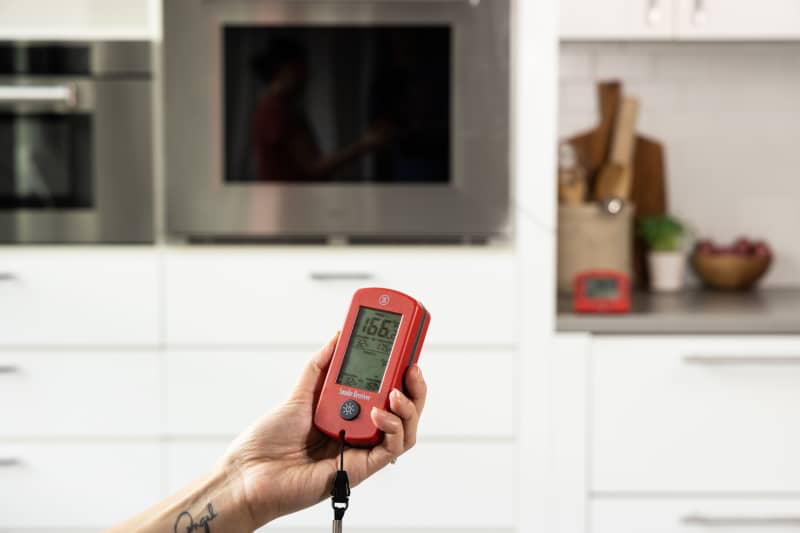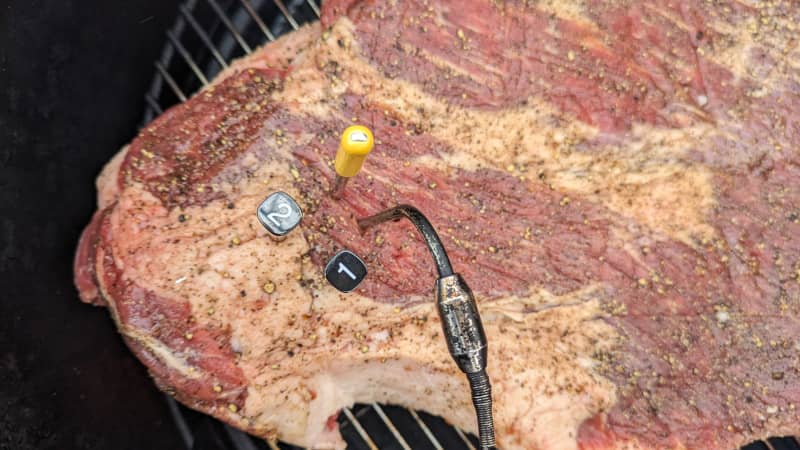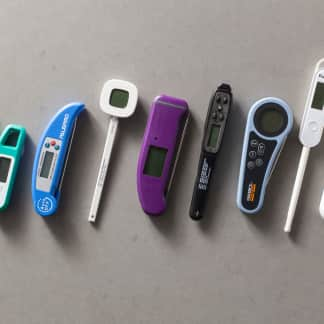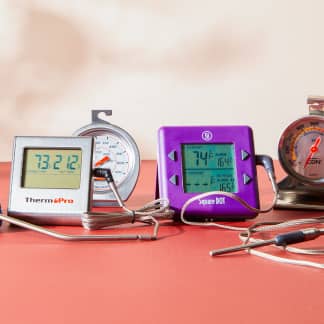We’ve recommended the ThermoWorks Smoke 2-Channel Alarm for several years and still think it’s the best option. It’s easy to use, allows you to take the temperature of two pieces of food at once, and relays highly accurate temperatures for relatively long distances via a radio-transmission pager system. If you have a strong internet connection where you grill or barbecue and are willing to pay a bit more, we also love the FireBoard 2. Our upgrade pick allows you to track up to six different pieces of food (or air temperatures) at once and can send highly accurate temperatures to your phone even if you’re miles away. It’s a great option for serious barbecue enthusiasts or other folks who often handle multiple long-cooking roasts. We also have a Best Buy, the ThermoPro TP920 Dual Probe Bluetooth Meat Thermometer. Because it uses Bluetooth to transmit signals, it isn’t able to broadcast them quite as far as our top picks. But it’s otherwise inexpensive, accurate, and easy to use, making it a good option for folks who want temperature alerts with a little more distance from their food.

We typically use a leave-in thermometer to monitor the temperature of long-cooking foods—roasts and barbecue—without having to open the oven or grill. (We prefer to use an instant-read thermometer to take the temperature of quick-cooking food such as a steak or a piece of fish.) Instead of repeatedly taking the temperature of your food, as you would with an instant-read thermometer, all you have to do is insert a leave-in temperature probe into your food and walk away. The probe connects to a display that reads out the temperature and will sound the alarm once your food is at your desired temperature.
There’s just one issue with these simple, helpful tools: If you’re not within hearing range of the thermometer, you won’t necessarily get the alert that tells you when your food is done. Enter remote thermometers. These thermometers work the same way as leave-in thermometers, with one critical advantage: they push temperature notifications to either your phone or a pager-style device that you can carry wherever you go. You don’t have to hover near your food the entire time it cooks, because your phone or the pager will alert you when it’s done, freeing you up to do other tasks around the house or yard as you wait.

Some remote thermometers are wireless and/or feature smart technology that will predict how soon your food will be done—added bonuses. Basically, these thermometers take you off of babysitting duty, making them a worthy investment for anyone who makes a lot of roasts or barbecue.
What Are the Different Types of Remote Thermometers?
Remote thermometers take two basic forms: wired and wireless.
Wired remote thermometers use temperature probes that are connected via a wire to a base. You insert the probe into your food, and the wire transmits the food temperature data to the base, which then relays that data to either your phone or a handheld monitor or pager that you carry with you (as you would a walkie-talkie or baby monitor).

Wireless remote thermometers, as their name suggests, have no wires. Instead, they are nail-shaped probes that you insert into your food and that transmit temperature data to your phone, either sending the signal directly or by relaying it to a base that amplifies the signal and then sends it to your phone.
How Do Remote Thermometers Work?
Remote thermometers use different types of radio signals to transmit temperature data. Some operate using Bluetooth, others use Wi-Fi, and a third category uses simple radio transmission. All transmit at the common frequency of 2.4 gigahertz.
But the type of radio signal can greatly affect the range of transmission—i.e. how far away you can go from your food and still receive data on your food—though the size of both transmitter and receiver antennae, the transmission power of both devices, and the material and type of antenna, also play roles.
| Bluetooth | Wifi | Simple Radio Transmission | |
|---|---|---|---|
Pros | Pros
| Pros
| Pros
|
Cons | Cons
| Cons
| Cons
|
Each type of radio signal has different pros and cons.
- Bluetooth: The most common type of remote thermometer and usually the cheapest. You’ll need a phone for these models, and as long as the phone you’re trying to pair with a device is within a certain distance, you’ll have a connection. The plus side is that Bluetooth is not dependent on internet or cell service, so the connection continues to transmit signals in cellular dead zones. Unfortunately, in our experience, Bluetooth-enabled models have the shortest range of transmission. Bluetooth requires relatively little power to operate, which is why many manufacturers choose it as a transmission mode—it’ll work even if you have a wireless thermometer with a tiny battery embedded within the probe itself. The problem is, power is exactly what’s required to make a signal from your thermometer travel long distances. The less power your thermometer uses, the smaller its range will be. For many of the Bluetooth-only models we tested, we had to be pretty close to the probe to get a signal—10 to 20 feet or so. Some Bluetooth thermometers come with special bases that can amplify the signal so that it can travel slightly longer distances. While these do help, most don’t extend the range as significantly as we’d like.
- Wi-Fi: You’ll need a phone and a good internet connection for Wi-Fi–enabled thermometers. If you have both of these things, these Wi-Fi–enabled thermometers are amazing, providing the longest range of transmission of any of the devices we’ve tested and letting you monitor your food temperature from miles away. But they’re only as good as your internet is dependable: If you’re making barbecue somewhere in a field (or even a backyard) where there’s no Wi-Fi, these thermometers won’t help you much. And they generally require larger, heavier batteries to supply the greater power required to transmit Wi-Fi signals. The Wi-Fi–enabled thermometers that we’ve tested are significantly more expensive than other types, too, though this is largely because both models we’ve tested come with multiple sensors or inputs.
- Simple Radio Transmission: Radio-transmission models send data to either a phone or a pager-style device, depending on the design. These models strike a happy balance between Bluetooth and Wi-Fi models. With more power than Bluetooth models, they’re able to transmit temperatures within about 30-40 feet, in our experience, though your results may vary.
Regardless of the type of radio signal, though, it’s important to note that external factors can also play a role in determining the range of the device. Any dense physical object—including barriers such as the walls of a house or a grill or an oven door—can obstruct a signal and limit how far it reaches. For this reason, transmission ranges are rarely as great as advertised. (See FAQ below.)

Many of the thermometers relay temperature information directly to your phone, letting you know when your food is done.
What to Look For
- Simple Radio Transmission or Wi-Fi: These modes of transmission send temperature data over longer distances more reliably than Bluetooth-enabled models—about 30 to 40 feet for radio transmission models and potentially miles away for the Wi-Fi ones. While we can’t completely write off Bluetooth models, these have several disadvantages that have made them less powerful in transmitting temperatures. As explained above, we found that these struggled to transmit temperature data over even short distances; some models disconnected within as little as 10 feet from their probes. Some models come with or allow you to purchase special boosters, which amplify the signal and extend the transmission range. While these work, they don’t always improve transmission as well as we’d like. If you don’t plan to go too far from your thermometer, a Bluetooth model might serve you fine, but it won’t be quite as powerful as other types of remote thermometers.
- Wired Models: These models had thinner probes that put smaller holes in our food. They often transmitted temperatures more reliably too.

- Easy Setup: We preferred models with apps or interfaces that were easy to set up and pair with the temperature probes.
- Clear, Uncomplicated Apps or Displays: We liked models with apps and displays that made it easy to set target temperatures and showed current temperatures, target temperatures, and time elapsed clearly, without too much extra noise. Large numbers and bold readouts were essential.

- Accuracy: The best remote thermometers had probes that registered temperatures within a degree of the correct temperature. We preferred those that deviated as little as possible.

- Loud Alerts: These made it obvious when our food had reached its target temperature, or when our phones or pagers had gone out of the transmission area and disconnected.
- Maximum and Minimum Temperature Targets: We appreciated models that let us set both maximum and minimum temperature alerts. Maximum temperatures are useful when cooking foods to a specific doneness. Minimum temperatures are important if you’re monitoring variable air temperature, as you might in a grill or smoker—you don’t want your heat level to fall too far below your target range or your food won’t cook properly.
- Battery Power or Easy Charging: We preferred models that used removable batteries for power or could be charged easily.
Nice to Have
- Two or More Probes: While you only need one probe to monitor a single piece of food, extra probes let you track other pieces of food or air temperature, which can be handy if you’re roasting several pieces of meat at once or want to monitor your grill or smoker’s ambient temperature.
- Data Logging Capacity: Several thermometers graphed out and saved the temperature data as we cooked and allowed us to leave notes on the graph for reference. While this feature isn’t essential for most people, we think serious barbecue enthusiasts might appreciate it, as the graphs give valuable feedback on temperature and speed of cooking for future sessions.
What to Avoid
- Complicated or Impossible Setup: Some of the models we tested were difficult to consistently pair with our phones, even after downloading the latest updates. No matter how accurate a thermometer is, it’s not much good to you if it can’t actually communicate temperatures.

- Buggy, Busy Apps: Several apps had interfaces that were tricky to navigate and made it hard to select target temperatures or customize settings. Others were glitchy and shut off suddenly or froze without warning.
- Inaccuracy: We deducted points from models that weren’t able to transmit temperatures within a degree of the correct ones.
- Poor Charging: Several of the wireless thermometers we tested didn’t always charge properly when set back in their designated bases. As a result, we’d sometimes take the thermometer out for use only to find that it was low on battery, even though the base had been plugged in overnight—a big bummer.

Other Considerations
- Wireless Models: We love the idea of wireless thermometers, as they make for tidier, easier temperature taking. Unfortunately, we’re not sure any we’ve tested are quite ready for prime time yet. There are a few basic design issues to consider. Wireless thermometers have probes that are thicker than the temperature probes on wired models—4.5 to nearly 6 mm thick, compared with 3.5 to 4 mm. That’s because they must house not only sensors but also the transmitter and battery required to broadcast the signals. Because they’re thick, they put larger holes in food; while this didn’t noticeably change the food’s quality, we weren’t wild about how it looked. In addition, several of the wireless thermometers we tested contain multiple sensors at different intervals along the probe (see below). Not all of these sensors can withstand high temperatures, so to prevent damage, manufacturers recommend that the probes be submerged in your food to specific depths to keep those sensors from encountering higher heat. And to get data from all the sensors, you sometimes need to insert the wireless thermometer more deeply than you might ordinarily, and at odd angles, making longer holes running through more meat. (For more information, see “Multiple Sensors” below). The models we tested had basic functioning issues as well. Some of the wireless models didn’t always pair or charge properly. And most run on Bluetooth, which doesn’t transmit data over long distances as well as we’d like. (As explained above, wireless thermometers rely on especially tiny batteries that don’t provide the power needed to broadcast over a great range.) We hope that this category will improve in years to come and will continue to monitor new products.

- Multiple Sensors: Several wireless thermometers had multiple sensors, allowing you to take the temperature of your food at different depths or measure ambient temperature. In theory, having extra data on your food’s progress seems like a good idea. In practice, though, it’s not always useful. We liked having the ability to take ambient temperatures, but because the sensors were so close to the food, they didn’t always reflect the temperature of the oven or grill that most recipes recommend. And it isn’t really all that helpful to know how fast the surface of your food is heating relative to the interior unless you have an incredibly unpredictable or poorly calibrated oven, grill, or smoker. (You don’t need temperature data to know your fire’s too hot if the outside of your food is charring 15 minutes into a recipe with a 4-hour cook time.) Finally, to take advantage of all the sensors, you often have to push the probe fairly deep into the food, making bigger holes than you might ordinarily. We think most people are better off using a single internal temperature to gauge food doneness.
- Predictive Technologies: Many “smart” remote thermometers promise to predict how long it’ll be until your food is done. This seems like a great feature, but these predictions were rarely even close to accurate until the food was almost done. We did appreciate models that we could set to provide a 5- or 10-minute warning before they anticipated our food would reach its target temperature—this helped us prepare.
The Tests:
- Set up all models according to manufacturers’ instructions and pair smartphone-connected models to phone
- Monitor temperature of Texas Barbecue Brisket and air temperature (where applicable) on charcoal grill for 7-8 hours
- Monitor temperature of North Carolina Barbecue Pork and air temperature (where applicable) on smoker for 5-6 hours
- Monitor temperature of Weeknight Roast Chicken in oven for 1 hour
- Establish transmission range by walking away from probe or base until receiver loses connection, making sure to travel behind walls, up and down stairs, and in areas with low cell and Wi-Fi service to test signal strength
- Test probe accuracy using ice bath and lab-calibrated reference thermometer
- Clean probes after each test
How We Rated
- Setup: We rated the models on how easy their probes and bases were to set up and pair with their receiver or relevant apps.
- Connectivity: We noted the range and consistency of each thermometer’s connection to its receiver or a smartphone and its ability to regain connection when back in range.
- Ease of Use: We evaluated how easy it was to set and silence alarms and set custom target temperatures, how clear and legible the displays were, and how intuitive the apps were to operate.
- Accuracy: We rated the models on how accurately their probes reported temperatures.


 Buy at ThermoWorks
Buy at ThermoWorks
 Buy at Fireboard
Buy at Fireboard


















